Beginner's Guide to Rain Gear for Backpacking
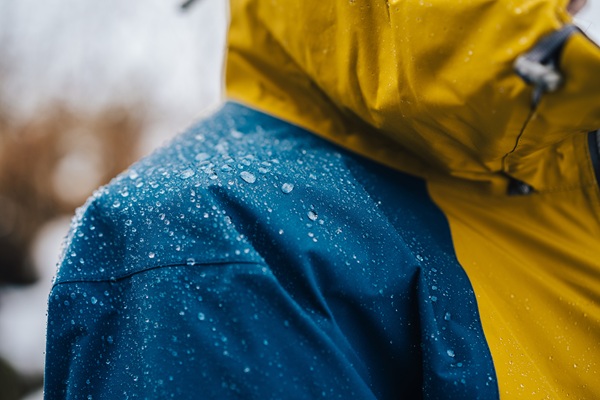
Table of Contents
Waterproof Rating (Hydrostatic Head)
A fabric’s waterproofness is indicated by its hydrostatic head (HH)–the height of water in a 1″-diameter cylinder that will cause leakage through the fabric. The unit of HH is mm.
Your rain gear should have an HH value of at least 10,000.
Breathability
Breathability is important for keeping you dry. If your rain gear isn’t breathable, you’ll become soaked on the inside from trapped perspiration. There’s a trade-off between water resistance and breathability.
Fabric breathability can be measured in MVTR (Moisture Vapor Transmission Rate) or CFM (cubic feet per minute).
MVTR measures the number of grams of water vapor that can pass through one square meter of fabric per day (g/m²/24 hr). For rain gear, aim for an MVTR of at least 10,000. Rain gear with an MVTR of 20,000 or more is highly breathable.
CFM is the number of cubic feet air of air per minute that can pass through a fabric. Although CFM can be used to indicate breathability, it’s used more often to indicate wind resistance. Higher CFM values are correlated with higher breathability but lower wind resistance.
Laminates vs Coatings
Rain-gear fabrics have two types of waterproofing: laminates and coatings.
Laminates are more waterproof, breathable, and durable than coatings but are heavier and more expensive.
Fabric Waterproofing Types
In terms of waterproofness, there are 3 types of rain-gear fabrics:
- Waterproof/nonbreathable
- Waterproof/breathable (WP/B) + DWR
- Water-resistant/breathable + DWR
Waterproof/nonbreathable
Waterproof/nonbreathable fabrics are inexpensive and completely waterproof. However, if you hike or exercise while wearing them, you’ll quickly get soaked on the inside from trapped perspiration. In warm weather, a rain poncho may be a better choice because of its superior ventilation.
Waterproof/breathable + DWR
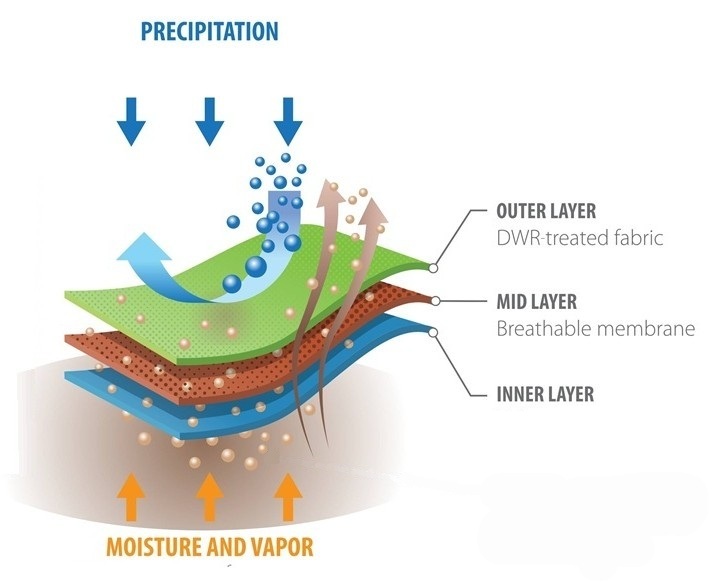
Waterproof/breathable (WP/B) fabrics let your sweat evaporate to keep you dry. Well, sort of.
The oversimplified explanation of WP/B fabrics is that their pores are large enough to let water vapor out but not to let liquid water in. Actually, the main mechanism of their breathability is the humidity differential between the inside and outside of the fabric. When the humidity is lower on the outside, moisture moves outward to establish equilibrium. When the fabric’s outer surface gets wet, however, the moisture stops moving outward and can even move inward. This is called “wetting out.”
For WP/B fabrics to work, they must be coated with durable water repellent (DWR). DWR keeps the fabric’s outer surface dry so the humidity differential can move perspiration outward. When the DWR wears off, the fabric loses both waterproofness and breathability. It’s important to periodically treat WP/B raingear with DWR.
Even with sufficient DWR treatment, WP/B fabric only works up to a point. Its breathability rate generally doesn’t keep up with the perspiration rate of most hikers, especially in humid weather. It’s also hot in warm, rainy weather, causing you to sweat faster than the fabric can breathe. In warm weather, a rain poncho may be a better choice.
WP/B shells are expensive. On one hand, their high cost and limited effectiveness might be good reasons to choose inexpensive non-breathable waterproof rain gear. On the other hand, limited breathability can be better than no breathability.
Common brands of WP/B fabric are Gore-Tex, eVent, and Neo Shell. WP/B fabrics are sometimes sold in different classes with different performances and prices. Gore-Tex Pro is more durable, breathable, and expensive than regular Gore-Tex.
Water-resistant/breathable + DWR
Water-resistant/Breathable rain-gear fabrics rely entirely on DWR to keep water out. They’re the most breathable but least waterproof.
Comparison of Fabric Waterproofing Types
| Waterproof/non-breathable | Water-resistant/breathable | Waterproof/breathable | |
|---|---|---|---|
| Waterproof performance | Perfectly waterproof | Good with DWR Useless without DWR | Good with DWR Limited without DWR |
| Breathability | Zero breathability | Best | OK |
| Cost | Low to moderate | Low to moderate | Most expensive |
Fabric Layer Constructions
WP/B rain-gear can have 3 types of layer constructions:
- 2-layer
- 2.5-layer
- 3-layer
2-layer construction
- Outer “face” layer: durable fabric coated with DWR
- Second layer: bonded waterproof/breathable membrane such as Gore-Tex
- Many 2-layer rain jackets have a hanging liner, usually mesh, that protects the membrane. The liner isn’t considered a layer.
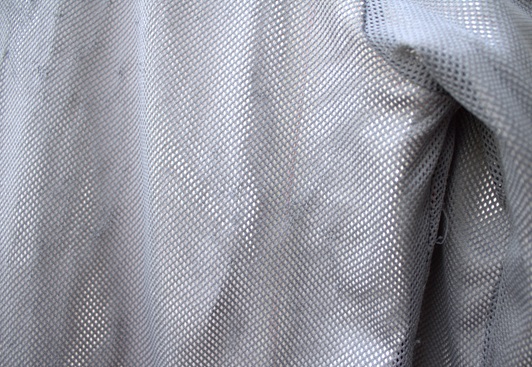
2.5-layer construction
- Outer “face” layer: durable fabric coated with DWR
- Second layer: bonded waterproof/breathable membrane such as Gore-Tex
- “Half layer”: printed- or sprayed-on liner that protects the membrane
3-layer construction
- Outer (face) layer: durable fabric coated with DWR
- Second (middle) layer: bonded waterproof/breathable membrane such as Gore-Tex
- Third (inner) layer: thin fabric affixed to the membrane
Comparison of 2-layer, 2.5-layer, and 3-layer Constructions
| 2-layer | 2.5-layer | 3-layer | |
|---|---|---|---|
| Waterproof performance | Good | Good | Best |
| Breathability | OK | OK | Best |
| Durability | Somewhat durable | Least durable | Most durable |
| Weight | Heaviest | Lightest | Medium weight |
| Cost | Moderate | Cheapest | Most expensive |
Rain Jackets/pants and Hard Shells
There are no standard criteria for distinguishing hard shells from regular rain jackets or pants. A clothing company can call anything a hard shell, so take the term with a grain of salt. However, the terms tend to be used as follows:
| Rain Jacket/Pants | Hard Shell |
|---|---|
| 2 or 2.5 layers | 3 layers |
| Thinner fabric | Thicker fabric |
| Lighter | Heavier |
| Less durable | Highly durable |
| Less abrasion-resistant | Highly abrasion-resistant |
| Less waterproof | Highly waterproof |
| Less windproof | Highly windproof |
| Less breathable | Highly breathable |
| Medium-sized hood | Sometimes larger hood |
| Medium fit | Sometimes longer fit |
| Less expensive | More expensive |
Hard shells are often just called shells. This term can be confusing because there is another kind of shell called a soft shell. “Shell” usually means “hard shell” by default unless “soft shell” is specified.
3-in-1 Jackets
3-in-1 jackets have an inner fleece mid layer and a waterproof-breathable outer layer connected by a zipper so they can be separated.
Soft Shells
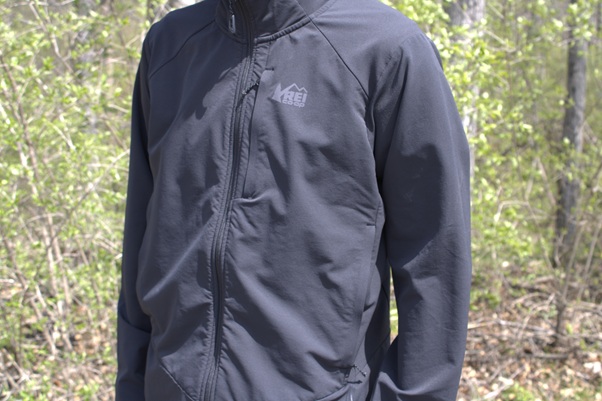
Soft shells are stretchy, water-resistant, and highly breathable.
Although soft shells can be useful for hiking, I don’t recommend them for budget backpacking because they add unnecessary weight and cost. However, they are indispensable for cross-country skiing and intense physical exertion at temperatures below freezing, especially in wind and snow.
Pit Zips
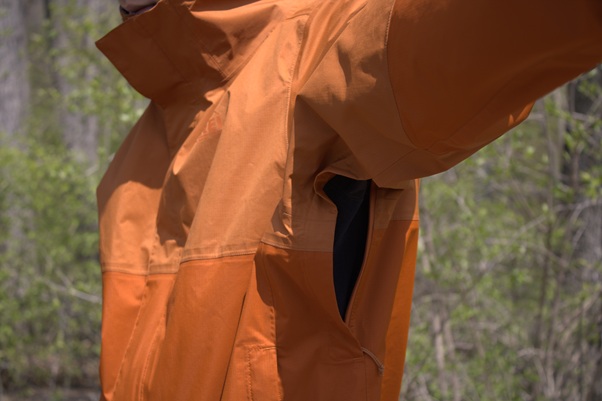
Some rain jackets and shells have pit zips, zippered openings under the armpits that allow heat and moisture to escape to reduce sweat condensation.
